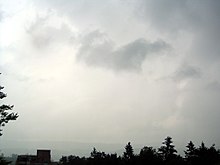Trough (meteorology)
A trough is an extensive area of relatively low atmospheric pressure. In the trough system or trough weather conditions there are two versions: the upper level trough and surface trough .
Floor trough / back trough
The bottom trough or also back trough describes areas of low air pressure on the back of a strong, already aging depression behind its cold front or occlusion . In these areas there is a renewed deepening of the cyclones as a result of the vigorous slide-up processes of the air masses , which arise when the warm air at the front of the low is guided counterclockwise around the center of the low and reaches the area of the cold air on the rear.
Floor troughs are not completely enclosed by higher pressure , which distinguishes them from lows. In addition, they do not have a closed vortex circulation . As a rule (northern hemisphere) the isobars of the cold air are “sack-shaped” bulging in a southerly direction, so it is the opposite of an omega weather situation .
The isobars bulge from the core of the deep in the shape of a wedge or trough, whereby the bottom trough, unlike a front, does not separate different air masses from one another. One speaks of a trough as long as the circulation is not completed. As soon as there is a closed circulation in the trough area and a closed core is formed, one speaks of a trough deep .
determination
A floor trough is announced by the fact that after pulling through the front, there is no air pressure increase as usual and the wind turns back again after a previous strong right turn, but the air pressure continues to fall again after a short increase. The floor trough follows a cold front or occlusion usually at an interval of around 15 to 20 hours and then brings another significant deterioration in the weather, which is usually accompanied by very strong gusts of wind .
The cloud cover in trough locations can differ fundamentally. Sometimes a closed nimbostratus cloud can prevail, from which long lasting to shower-like precipitation falls. Most of the time, however, the unstable air stratification leads to extensive accumulation with shower and thunderstorm cells.
High trough
The high trough is created by the meandering of the jet streams . The high trough consists of deep-reaching cold air, mostly of polar origin. If the jet stream bulges to the south, a high trough is created. If the jet stream bulges to the north, a vertical wedge or ridge is created .
Elevated troughs are mostly located in layers of air above 4000 m.
On the front of the trough, the high wind has a south-westerly or southerly current. Here, warm air is transported to the northeast or north. On the other hand, on the back of the trough, the high-altitude wind has a north-westerly or northerly current and cold air is transported to the south-east or south.
Troughs and ridges are effects of the Rossby waves .
determination
Altitude troughs can be recognized by the strong, cyclonally curved isohypses on the altitude weather map. The standard map is usually the map of the 500 hPa pressure area, which is on average at an altitude of 5500 meters.
Effects
The high and low formation on the ground is very closely related to the troughs and ridges.
In a high trough , the contour lines ( isohypses ) in the area of the trough axis have a strong curvature. In front of the trough axis, the flow lines converge more closely, they converge. This increases the wind speed in the area of the trough axis. Due to the strong curvature of the flow lines in the area of the trough axis, the air mass is slowed down, which means that the air masses accumulate in front of the curvature. The accumulating air masses are mainly transported downwards because the end of the troposphere prevents them from being transported upwards . Falling air masses mean increasing air pressure on the ground, which creates a high pressure area on the back of a trough .
Behind the trough axis, the curvature of the streamlines rapidly decreases, and the streamlines diverge, they diverge . As a result, more air masses are transported away at the exit of the high trough, which leads to a lack of mass. Air masses flow in from below to compensate. Rising air masses drop the air pressure on the ground, and a low pressure area is created on the ground . Low pressure areas on the ground on the front of troughs are very weather-active due to the uplift of the air masses and deepen here strongly. The same applies to fronts .
Even after high and low education, height troughs control the shifting of the pressure systems close to the ground. For example, lows close to the ground shift to the deep depending on the axis inclination of the height trough: A vertical axis inclination leads to a stationary low, an eastward inclined axis leads to the development of a low or shifts an existing low eastward. A backward tilt of the axis leads to a shift to the west or a weakening of the depression.
Short wave trough
At the border with the warm air, short wave troughs appear as smaller bulges on the edge of the large bulge. As small-scale low pressure areas, they move in rapid succession along the jet stream to the northeast. They are harder to see. They are usually quite weather-effective and can lead to rain, snow, violent thunderstorms and tornadoes.
swell
- Karl-Heinz Bock, Ralf Brauner, Frank-Ulrich Dentler: Seewetter , DSV-Verlag GmbH, Deutscher Segler-Verband-Verlag GmbH, 2009, ISBN 978-3884123676
- Gravure trough in WetterOnline's weather lexicon
- Trough at Wissen.de



